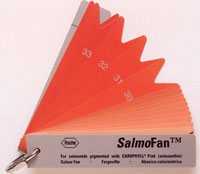|
There's a major difference between wild salmon and farm-raised fresh salmon: without certain additives, the flesh of the farm-raised salmon would not have that familiar colour to it. Farm-raised flesh would be grey.
The naturally occurring colour of the flesh of wild salmon comes from carotenoids, such as astaxanthin. In nature, these carotenoids are produced by certain micro-organisms and plant life. Wild salmon obtain carotenoids from their diet of small shrimp and small fish. A specific carotenoid , asataxanthin, is found in 90 per cent of salmon in the wild.
|
